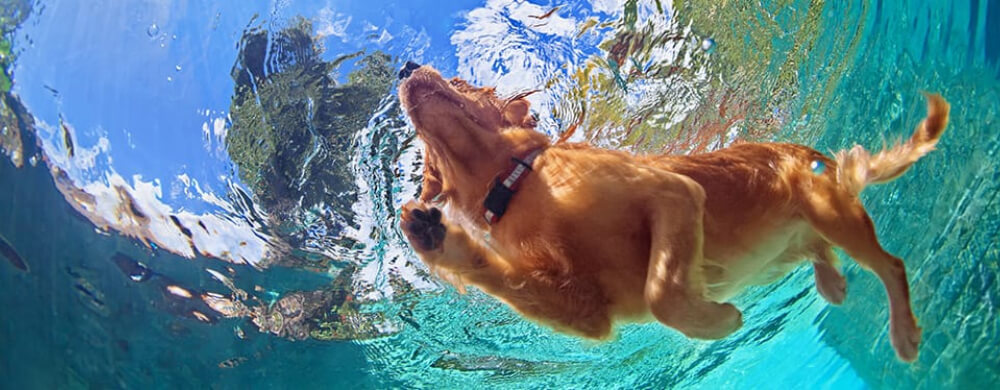Just like us, pets love summer! After all, what could be better than three whole months of weather that’s perfect for swimming, grilling, camping, and road trips? But just like us, our pets need special care to avoid the hazards that come along with hot weather — and the activities that go with it.
As with any good thing, too much sun can be a problem for pets. Dehydration, heatstroke, and even sunburn can cause serious health problems.
Certain breeds are more susceptible. This includes brachycephalic (flat-faced) canines such as pugs, Boston terriers, and bulldogs, and Persian cats, whose anatomy makes it harder for them to pant effectively. Also, pets with short, light-colored coats can sunburn more easily.
With a little preparation and awareness, you can make sure that you and your pet have a blast this summer.
Stay cool
To keep pets safe, limit your outdoor activities to the cooler daylight hours of early morning and dusk. Try to keep your pet indoors in a temperature-controlled environment during the hottest part of the day.
Air conditioning is optimal, but keeping shades drawn and using fans helps too. If your pet does venture outdoors during the heat of the day, make sure he has a protected area — such as a covered patio or shady lawn — where he can lounge safely.
Humid climates are especially tough on pets. Panting, which allows them to remove moisture from their lungs, is the main way pets cool themselves down. If the moisture content in the air is high, animals are essentially fighting a losing battle by panting. If you live in an area that’s especially sticky during the summer, be sure to keep a close eye on your furry friend.
Hydrate
Keeping your pet properly hydrated is incredibly important during the summer. Make sure he has plenty of cool water available morning, noon, and night. Filling your pet’s bowl halfway and placing it in the freezer overnight and then topping it off in the morning will help keep water cool throughout the day. Of course, you should always take plenty of fresh water with you on trips. Whether home or away, check to make sure your pet is drinking throughout the day.
During the summer, water is not just for drinking. A shallow plastic kiddie pool is a great way to keep your dog cool. If you’re lucky enough to have an actual backyard pool, letting your pup take an occasional dip is a fantastic idea as well. Just be sure to train your pooch how to enter and exit the pool safely before letting him dive in. Some breeds are not great swimmers, so make sure to talk to a veterinarian before offering your pooch a plunge.
Lakes, rivers, and oceans make for great summer swimming as well. Make sure the water is safe before you or your dog takes a dip. Ensure that lakes and swimming holes are free from harmful contaminants such as chemicals, algae, and parasites. Avoid fast-moving streams and rivers, and check with lifeguards about rip tides and undertows at the beach. Finally, don’t allow your dog to drink toxic saltwater. And if you head out on a boating trip, make sure your buddy wears a life jacket too.
Most cats aren’t interested in diving into a pool of water, so your chances of getting one to go for a swim are probably slim. Since most kitties are fine with a little moisture on their fur, try wiping them down with a damp cloth to help keep them cool.
No hot cars
Never leave your pet in a parked car during the summer. In hot weather, the temperature in a parked car can rise to a deadly level within minutes. According to a San Francisco State University study, the temperature can rise by 19° in 10 minutes. It can jump by 29° in 20 minutes and 34° in 30 minutes. After an hour, the temperature can climb by 43° to over 140° Fahrenheit.
Stay protected
Besides sun, surf, and sand, summertime also means fleas, ticks, and mosquitos. That’s why it’s even more important not to miss a dose of your pet’s veterinarian-recommended medication to ward off parasites during the summer months.
Pets can also get sunburned — especially those with light fur, pink skin, or a thin coat — which means they might need sunscreen. Check with a veterinarian about which products they recommend and apply a thin layer to the spots where your pet is most likely to get burned. This includes the bridge of the nose, tips of the ears, belly, and groin area. Never apply a spray sunscreen directly to your pet’s face; use a cotton ball instead.
Finally, make sure your pet’s paws are protected from hot outdoor surfaces. Reach down and touch that patio, deck, or pavement to check if it burns your hand. If so, it’s too hot for your pet to walk on. Postpone your walk until it’s cool enough, or walk on the grass instead. And be on the lookout for the signs of injured pads throughout the summer, like redness, visible blisters, limping, licking, and chewing. A veterinarian-recommended balm can help soothe sore paws, and doggie boots or socks can help protect them.
Know the warning signs
Despite your best efforts, your pet may still encounter a condition that requires veterinary attention during the summer. That’s why it’s important to monitor them for issues such as dehydration, sunburn, bug bites, and — most importantly — heatstroke.
The signs of heatstroke include excessive panting or labored breathing, increased heart and respiratory rate, drooling, and mild weakness. More acute symptoms include a body temperature of over 104° Fahrenheit, seizure, vomiting, and bloody diarrhea. If your pet experiences any of these symptoms, be sure to get him to a veterinarian right away.



